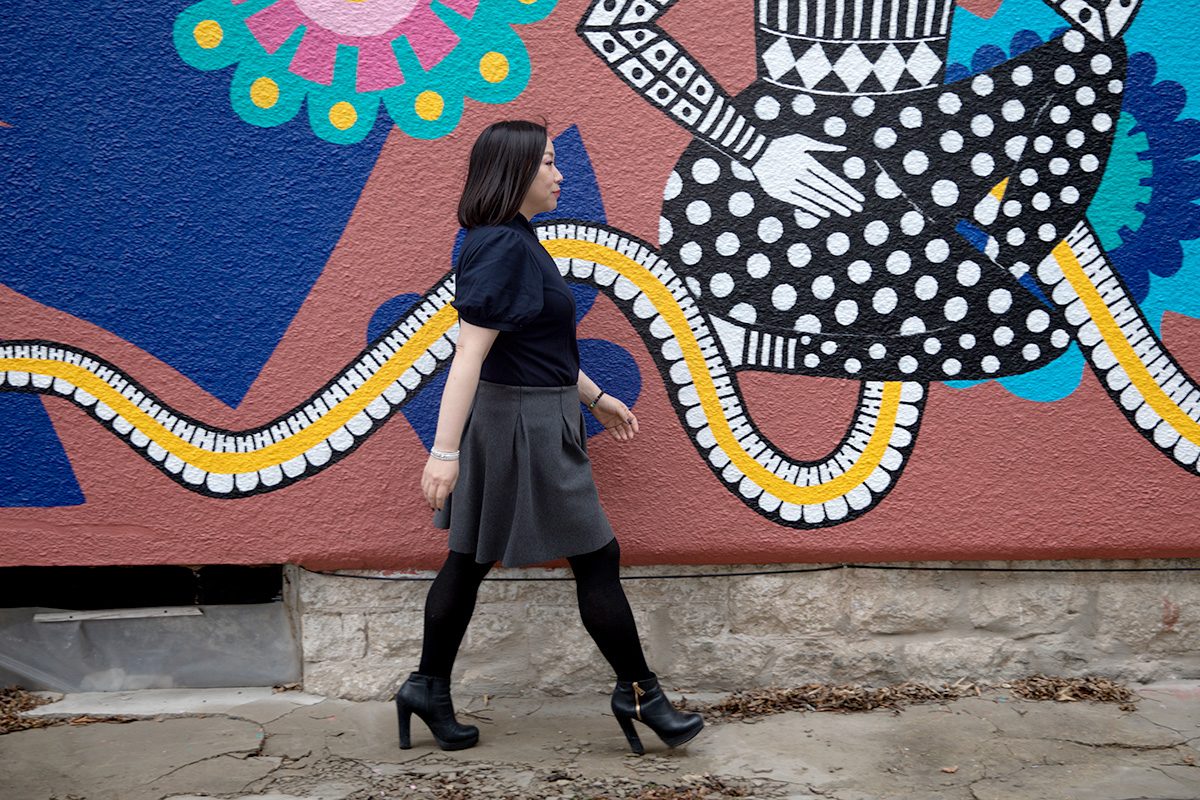
Hee-Jung Serenity Joo walks by 126 Sherbrook Street by Sandeep Johal.
Reading the world
The power of cultural narratives
Baton Rouge and books have been instrumental in shaping Hee-Jung Serenity Joo’s life and career.
Joo lived in many different places as a child, but it was the time that she spent in Baton Rouge, Louisiana, and the time that she spent in libraries – “learning English and becoming a bookworm” – that most impacted how she sees the world and her research agenda.
“Being Asian and attending public schools in a southern city with its legacies of slavery and segregation, gave me a distinct position to think about where I fit into this scheme of Black-white relations. I learned at an early age how Asians are both subjected to racism in the U.S. and benefit from anti-Black racism.” Joo says.
That thinking and questioning, combined with an impassioned reading of Toni Morrison’s novel Beloved when she was 12-years-old, led Joo to an undergrad degree in French and English literature from Louisiana State University and then a PhD in comparative literature from the University of Oregon.
Joo is an English, theatre, film and media professor in the Faculty of Arts, teaching and researching ethnic American literature and speculative, science and disaster fiction, as well as critical race studies and queer studies. Much of Joos’ research focuses on how people of colour navigate the structural and historical workings of white supremacy and colonialism through literature and the arts.

116 Sherbrook Street by Real Fresh Canvas Co (Trevor Peters & Annaliza Toledo).
“I look at how writers and artists of colour imagine the world in their texts, and I am interested in how imagination can be an incredibly powerful and necessary tool of resistance, solace and political transformation,” she explains.
“When the state does not recognize you,” Joo continues, “culture becomes a crucial site to express who you are. It’s a different understanding of culture. For people of colour, culture is the site of struggle and existence.”

116 Sherbrook Street by Real Fresh Canvas Co (Trevor Peters & Annaliza Toledo) with Hee-Jung Serenity Joo.

126 Sherbrook Street by Nereo Eugenio. (Nereo II)
Like many humanities scholars, Joo is committed to the idea that the pursuit of knowledge is never complete. Although she disseminates her research in all the conventional ways, including via peer-reviewed articles, book chapters and book reviews, she does not distinguish between her research and her teaching. Her classroom – whether she is teaching a survey course on American literature or a queer theory based course on racial futurities-is also a place of research. Her research, teaching and academic service are all connected and all equally vital to her ongoing pursuit of knowledge.
Joo also considers everything that she reads to be research.
“Popular culture is often dismissed as superficial, but it holds immense power. Everything I read and consume, on Instagram, in newspapers, on Netflix, in ads on buses, and on the back of a cereal box, is a potential site of analysis and research,” she says.
“Cultural narratives are everywhere around us, and it’s important that I teach my students the skills of cultural literacy so that they can better understand not only literary texts, but also the world they live in.”
Although Joo is never at a loss for topics to study, much of her recent attention has been taken up by science and disaster fiction.
“Science fiction historically was a genre of colonialism,” she explains. “It was about the discovery of new worlds and new people and conquest and exploration, and so I am really interested when artists of colour reclaim science fiction and do new things with it.”
Whereas African Americans and Indigenous peoples are generally denied any role at all in traditional science fiction outside of being discovered or impeding conquest, Joo continues, Asian Americans are often typically represented in the genre as robots or techies.
That, she explains, is known as the model minority myth. It is based on the idea that Asians are the good racial minority and that other racial minorities should attempt to emulate them.
“This is a classic tactic of colonialism, to divide and conquer,” Joo continues, “as this supposedly positive image of Asians is promoted to keep other minorities down. At the same time, model minority Asians are presented as aberrant—they are freakishly good at mundane tasks and multiple-choice exams, and there are ‘too many’ of them in university, in the neighbourhood, on the planet. All of this together helps to secure whiteness as the norm.”
As part of this research, Joo is currently writing a paper on representations of Asians as robots and cyborgs. She is also in the midst of researching the racial politics of disaster, thinking through what gets classified as a disaster and by whom, and also thinking about the colonialist timelines of global warming and climate change as mass disasters. And then there’s her research cluster on collecting, citing and curating; her collaboration on a local grant on the rights of incarcerated people; and her intention to offer U of M courses on the inside at the Women’s Correctional Institute in Headingly, Man. where she currently volunteers.
As a literary scholar who cares deeply about culture, racial politics and the future of humanity, Joo views the entire world as her laboratory. And in that laboratory, the quest for knowledge is never ending.
Humanities hub
Somehow, in spite of the research she’s pursuing, the papers she’s writing, the courses she’s preparing, the graduate students she’s supervising and the countless books and tweets and other media that she is reading, Hee-Jung Serenity Joo finds time to dedicate to the U of M’s Institute for the Humanities (UMIH). Joo began a three-year term as the institute’s director last summer.
The UMIH was created almost 30 years ago to promote cross-disciplinary research in the humanities and allied social sciences, and sponsor public programs, lectures, workshops, colloquia and conferences to highlight that research.
“We function as a hub for scholars in the humanities to come and share their work,” Joo explains.
“We provide resources and support to help researchers do what they are already doing, better, and help link people with others who may be interested in similar ideas and research.”
Currently, that research is concentrated in two main clusters. One of those clusters is connecting humanists to health sciences scholars. The other cluster – one which Serenity co-organized long before being named institute director – is focused on collecting, citing and curating, and brings together academics, archivists and artists of colour.
“I love that I get to work with visual artists,” Joo says, “as my work is bending toward the visual arts more and more as a medium that can express certain problems in ways that narrative often can’t.”
The institute also sponsors affiliates who, at the present time, are delving into topics as diverse as hyper-empathy in Romantic era literature and the contemporary obsession with psychopaths.
“The best part about being director is I get to attend talks on a wide range of topics,” Joo says. “It stretches my brain in so many directions [and is] incredibly stimulating.”
This story originally appeared in the Summer 2019 issue of ResearchLIFE.
Research at the University of Manitoba is partially supported by funding from the Government of Canada Research Support Fund.






